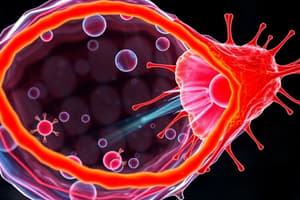Podcast
Questions and Answers
What is the process in which water molecules enter an animal cell across a selectively permeable cell membrane?
What is the process in which water molecules enter an animal cell across a selectively permeable cell membrane?
- Diffusion
- Osmosis (correct)
- Endocytosis
- Active transport
When a plant cell is in a hypertonic solution, it will become turgid.
When a plant cell is in a hypertonic solution, it will become turgid.
False (B)
What happens to a cell when it undergoes lysis?
What happens to a cell when it undergoes lysis?
It bursts and releases its contents.
Active transport requires energy released from the process of respiration in living cells to move particles against a concentration ________.
Active transport requires energy released from the process of respiration in living cells to move particles against a concentration ________.
Match the following with their outcomes in plant cells in different types of solutions:
Match the following with their outcomes in plant cells in different types of solutions:
Define diffusion.
Define diffusion.
Explain osmosis.
Explain osmosis.
Which statement is true about diffusion?
Which statement is true about diffusion?
Diffusion always involves a gain or loss of energy.
Diffusion always involves a gain or loss of energy.
Osmosis is the movement of water molecules from a region of higher water potential to a region of lower water potential, down a water potential gradient, through a selectively permeable ______________.
Osmosis is the movement of water molecules from a region of higher water potential to a region of lower water potential, down a water potential gradient, through a selectively permeable ______________.
Match the following terms with their definitions:
Match the following terms with their definitions:
Flashcards are hidden until you start studying
Study Notes
Diffusion, Osmosis, and Active Transport
Diffusion
- Diffusion is the net movement of particles from a region of higher concentration to a region of lower concentration, down a concentration gradient.
- Particles move down a concentration gradient until the concentration is uniform throughout.
- Diffusion occurs spontaneously and does not involve any energy taken in or given out.
- The rate of diffusion depends on:
- Concentration gradient: The greater the difference in concentration, the higher the rate of diffusion.
- Distance: The shorter the distance, the higher the rate of diffusion.
- Area: The larger the surface area, the higher the rate of diffusion.
- Size and nature of the diffusing molecule: Small molecules diffuse faster than large ones.
Osmosis
- Osmosis is a special case of diffusion, where water molecules move from a region of higher water potential to a region of lower water potential through a selectively permeable membrane.
- A selectively permeable membrane allows certain molecules to pass through, but not others.
- Osmosis is important for living organisms, as water enters and leaves cells through their cell membranes.
- Effects of osmosis:
- Plant cells: Water enters the cell, causing it to swell and become turgid.
- Animal cells: Water enters the cell, causing it to swell and eventually burst.
Active Transport
- Active transport is the process of moving particles against a concentration gradient, from a region of lower concentration to a region of higher concentration.
- Energy is required for active transport, which is released from the process of respiration in living cells.
- Active transport is carried out by a series of carrier proteins within the cell membrane.
- Examples of active transport:
- Root hair cells in plant roots absorbing nitrate ions from the soil.
- Cells in the small intestine absorbing glucose and amino acids from the lumen.
Differences between Diffusion and Active Transport
- Diffusion: Transports dissolved substances from higher to lower concentration, requires no additional energy input.
- Active Transport: Transports dissolved substances from lower to higher concentration, requires energy from respiration in living cells.
Studying That Suits You
Use AI to generate personalized quizzes and flashcards to suit your learning preferences.





